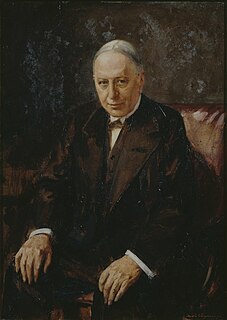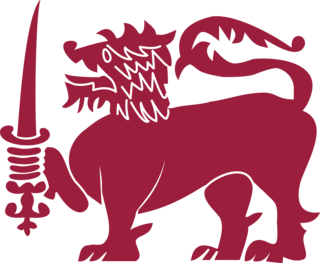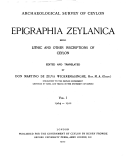The topic of this article may not meet Wikipedia's general notability guideline .(May 2017) |
The Royal Asiatic Society of Sri Lanka (Ceylon before 1972) has published a journal since 1845. [1]
The topic of this article may not meet Wikipedia's general notability guideline .(May 2017) |
The Royal Asiatic Society of Sri Lanka (Ceylon before 1972) has published a journal since 1845. [1]

Thomas William Rhys Davids was an English scholar of the Pāli language and founder of the Pāli Text Society. He took an active part in founding the British Academy and London School for Oriental Studies.

The Royal Asiatic Society of Great Britain and Ireland, commonly known as the Royal Asiatic Society (RAS), was established, according to its royal charter of 11 August 1824, to further "the investigation of subjects connected with and for the encouragement of science, literature and the arts in relation to Asia." From its incorporation the society has been a forum, through lectures, its journal, and other publications, for scholarship relating to Asian culture and society of the highest level. It is the United Kingdom's senior learned society in the field of Asian studies. Fellows of the society are elected regularly. Fellows include highly accomplished and notable scholars of Asian studies. They are entitled to use the post-nominal letters FRAS.

Karava is a Sinhalese speaking ethnic group of Sri Lanka, whose ancestors migrated from the Coromandel coast of Tamil Nadu, claiming lineage to the Kaurava royalty in the old Kingdom of Kuru in Northern India. The Tamil equivalent is Karaiyar.
The following is a chronological overview of the history of the Karavas and Karaiyars caste of Sri Lanka and India. Both communities were historically also known as Kurukulam, meaning Kuru clan.

Robert Chalmers, 1st Baron Chalmers, was a British civil servant, and a Pali and Buddhist scholar. In later life, he served as the Master of Peterhouse, Cambridge.
Paulus Edward Pieris Deraniyagala (1900–1976) was a Sri Lankan paleontologist, zoologist, and artist.

A Bandâra was a Great Officer in the Amātya Mandalaya, or Sinhalese Council of State, in the Sinhalese Kingdoms of premodern Sri Lanka. A Bandâra was the sons of a chief in the Sinhala Kingdom.
The Royal Asiatic Society of Sri Lanka (RASSL) is based in Colombo, Sri Lanka. It is one of the oldest learned societies in Sri Lanka with a history of over 160 years. It was established on 7 February 1845, paralleling the Royal Asiatic Society of Great Britain and Ireland to further oriental research as the Ceylon Branch of the Royal Asiatic Society. In 1977 it was renamed the Royal Asiatic Society of Sri Lanka.

The National Museum of Kandy in Kandy, Sri Lanka is located next to the Temple of the Tooth in part of the former Royal Palace of Kandy. The primary exhibits are housed in the Palle Vahala building, which was the former home of the King's harem. A secondary exhibition is located in the main palace building. The museum is maintained by the Department of National Museums.

Sir Alexander Johnston, PC, FRS, was a British colonial official who served as third Chief Justice of Ceylon and second Advocate Fiscal of Ceylon. He introduced a range of administrative reforms in Sri Lanka, introducing numerous liberal ideas and supporting the rights of natives. He was also an orientalist and along with Henry Thomas Colebrooke and others he was a founding member of the Royal Asiatic Society of Great Britain and Ireland.
Christopher Gunapala Uragoda FRCP, FRCP, is a Sri Lankan physician, author, folklorist, historian and conservationist

Johan Gerard van Angelbeek was a Dutch colonial officer who commanded Dutch forces on the island of Ceylon during the colony's final year in the Dutch Empire before its seizure by a British expeditionary force.

Epigraphia Zeylanica is an irregularly published series that deals with epigraphs and other records from ancient Ceylon. Established in 1904, the series' contents range from individual articles and notes on inscriptions to single-author monographs. Over the last century, Epigraphia Zeylanica has functioned as a key source for the history of ancient Ceylon and its early epigraphic records.
John Stark was a Scottish lawyer who became the ninth Queen's Advocate of Ceylon.
Sir Paul Edward Pieris Deraniyagala Samarasinha Sriwardhana, was a Ceylonese civil servant and historian. He served as Ceylon's Trade Commissioner and a District Judge and held multiple appointments as President of the Royal Asiatic Society of Sri Lanka. Although his academic and early career was in the legal field, he is best known for being one of the country's foremost experts on the history of European occupation of Sri Lanka.
The Doric Bungalow at Arippu East, Mannar, Sri Lanka, was the residence of the first British Governor of Ceylon.
Kotugodella Fort, also known as Katugodalla Fort or Katugodælla Balakotuwa, was a Portuguese fort, located near Haldummulla. In 1630 the Portuguese, under the command of Constantino de Sá de Noronha attempted to use the ldalgashinna pass to force a way into the Uva. The fort was used as a staging post for troops in the attack.
The East India Association (EIA) was a London-based organisation for matters concerning India. Its members were Indians and retired British officials.
Robert Wilson Ievers CMG was a British-born Ceylonese public servant.